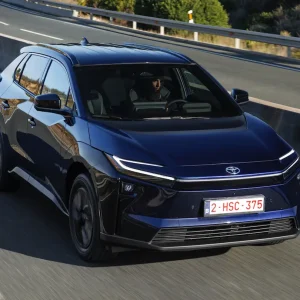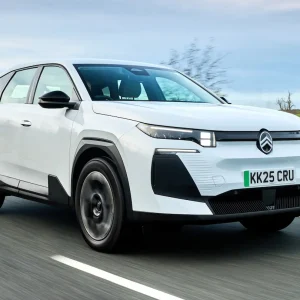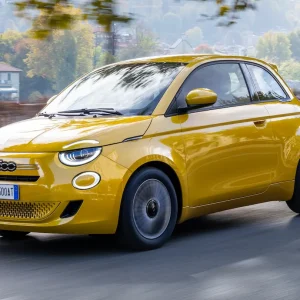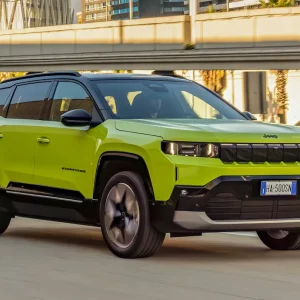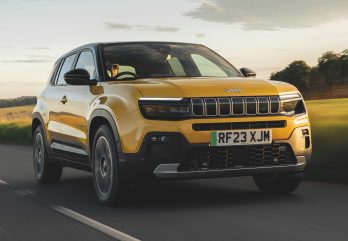
We got to drive the new Avenger first back in April this year, and prior to that we couldn’t explain how Jeep’s first EV had walked away with major awards, including the prestigious Car of The Year 2023 title. However, after spending time with the new Jeep, we began to understand why as it arrives on UK shores. It’s such an opportunity for the largely forgotten iconic American off-road brand – even if this SUV is only two-wheel drive for now.
Outside, the floating roof, chunky trapezoidal wheel arches, seven-slot sealed grille, and tall styling shout off-roader, but the Avenger still looks neat and attractive. Clever too, because items such as the front foglights and rear reflectors are encased within the bumpers to protect them from small, urban knocks. Designed and built in Europe, the Avenger’s raised ride height, short front and rear overhangs, underbody protection, plus sand, mud, and snow modes, even Hill Decent Control, are something different and equal in our opinion, what must be the most capable B-segment SUV around.
Inside, the Avenger is an attractive mix of a pre-Stellantis Fiat Group vehicle, alongside the familiar stalks, switchgear, and infotainment from the French side, with the lower button gear selector and higher bank of switches coming from the all-electric Fiat 500e. The Avenger feels spacious, especially in the front, stowage is impressive with a total of 34 litres around the interior, but taller rear passengers will be wishing for more space. Still, there’s a 380-litre boot and all this space is made more impressive when you learn that at 4,084mm the Avenger is 200mm shorter than sister car the Peugeot E-2008.
We’re not fans of the hard and shiny plastics for the doors and dashboard, but we suppose this fits in well with the toughness of the Jeep brand. We don’t like the Apple iPad-like magnetic cover for the deep central dashboard cubbie either. It feels cheap – and we wonder how long it will last.
As we mentioned above, the Avenger shares its basic platform with the Peugeot 2008 and Vauxhall Mokka, but the eCMP2, as it’s called here, gets 600 new dedicated components.
Stellantis is currently rolling out electric motor upgrades across the range, but it’s the Jeep that was first. The 400-volt M3 motor, Jeep claims improves range by 5%, and it produces 156hp and 260 Nm of torque.
255 miles of range seems about average for this class but is still competitive when compared to rivals. This is because of the Avenger’s new 54kWh battery, which is very compact and located under the front and rear seats and the central tunnel. When it comes to charging, this Jeep’s on-board charger delivers 100kW, equalling a 20 to 80% charge in just 24 minutes at a fast charger, with a 0-100% charge taking five and a half hours on an 11kW charger.
The steering wheel might be on the right now, but again our test car was in the top-spec Summit equipment grade. Fitted with 18in wheels, the ride remained refined and comfortable. The steering could do with more feel, and the soft ride and tall stance means there’s some body roll – but it is tidy and safe enough.
Performance is dependent on mode, but with 156hp it doesn’t feel overpowered. We kept the Avenger in ‘Normal’ mode mostly, and it seemed to suit this Jeep’s character best. For a sharper drive, ‘Sport’ worked equally well out of town – but this does eat into the range. The only other demerit are the brakes, which have a surprising amount of travel and feel a bit snatchy at low speeds.
Prices start at £35,700 for the entry-level Longitude, which seems decent value against rivals, rising to the Summit at £39,600. On this evidence, we’d say this Jeep totally justifies its European Car of the Year win and the Avenger is the best current EV made by the Stellantis group.
Jeep Avenger Summit
P11D: £39,045
Residual value: 47%
Depreciation: £20,570
Fuel: £3,566
Service, maintenance and repair: £2,108
Cost per mile: 43.74p
Range: 241-255 miles
CO2 (BIK %): 0g/km (2%)
BIK 20/40% a month: £12/£26
Luggage capacity: 380 litres
Battery size/power: 51kWh/156hp

